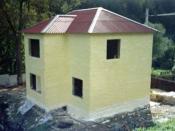Search
Login
Recommended
We choose a drill for metal, how to do it correctly, expert advice
To drill many different holes in the hardest materials, not to become dull and not to break, a high-quality metal drill is capable of. High performance from the drill can be expected if it is correctly selected for the drilled product, made of high quality material and sharpened as necessary.
Let us consider in detail the types of drills for metal, their characteristics, features of use and selection criteria for a cutting tool.
Content
- Drill for metal an indispensable tool of a modern builder
- Metal drill classification video
- Features of marking drill bits for metal
- What the color of the drill can tell
- Proper sharpening of the drill: the need for a process and algorithm of actions video
- The main recommendations for the selection of metal drills
Drill for metal an indispensable tool of a modern builder
A metal drill is used to cut holes in alloyed and unalloyed steel, its alloys, in non-ferrous metal, cast iron and other types of metal. Often such drills are used when working with hard plastic materials. The scope of drills for metal is unlimited: the tool is used in various fields of activity and in everyday life.

It is difficult for an ordinary buyer to navigate among the wide range of drills that are presented today in the construction market. Without competent consultation of a specialist, choosing a suitable model is quite difficult.
Structurally, a drill for metal has a working part (cutting and calibrating part) and a shank.
Drills for metal belong to the category of spiral, as along the entire length they have spiral grooves for removal of chips
The place at the end of the drill is the cutting part, where the pointed edges are located, which ensure the penetration of the drill into the material. Behind the cutting part is a calibration part equipped with grooves for removing metal chips. The calibration part is responsible for the smoothness of the edges of the hole and sets the desired diameter.

The material of manufacture and the structure of the working part determines the purpose of the cutting tool.
The drill is fastened to a hand tool or machine tool through a shank, which can have a conical, cylindrical or hexagonal shape.
Metal drill classification
Depending on the design features, metal drills can be divided into the following types:
- Screw (spiral) drills made in the form of a cylindrical rod, the edge of the drill has a conical shape. The angle of inclination of the recesses can vary up to 45 degrees. The conical drill bit for metal is characterized by reliability, strength and durability. The price of the drill will depend on the material of manufacture, the manufacturer and the size of the drill.

- Tapered Shank Twist Drill Designed to work on drilling machines or a two-handed special drill (the drill is mounted without a cartridge). The drill is clamped in the machine with a shank in the form of a cone. The size of the cone (there are five sizes in total) depends on the diameter of the hole being drilled. Such drills are more often used for drilling holes of large diameters.

- Core drill for metal, they are especially effective for drilling large holes or for multilayer drilling (making holes through several metal sheets at the same time). The drill design allows the use of not very powerful tools. A drill is made of high speed steel and has frequent teeth. When working with core drills, it is important to monitor the absence of vibration and to cool the metal in time, this will extend the life of the tool. It is better to choose models with a reinforced shank so that the drill does not slip out of the chuck.

- Step drill for metal is a relatively new solution for drilling metal. The main advantage of such drills is versatility. They can be used for drilling holes of various sizes: from 4 to 36 mm in diameter. However, such a drill can only cope with work on sheet metal, the thickness of which does not exceed 2 mm. A step drill is the best option for those who work exclusively with sheet metal (one drill can replace a set of drill bits for metal). The cost of a step product directly depends on the maximum possible diameter of the drill bit for metal.
- Left-side (left) drills are found on sale quite rarely, their main task is to drill a broken screw bolt. When working with a conventional drill, the bolt will scroll.
- Carbide drills are applied during the work with strong metal. The tip of the carbide drill is made of a particularly hard plate (VK8 alloy), the sharpening angle is one-sided sharp, which allows the drill to easily penetrate deep into the material. Such drills are not always on sale, but they can be bought on order.
- Drills for metal of various types and diameters have a series of release along the length (standard, elongated, long). Elongated drill will not be much longer than the usual of the same diameter. After all, a drill with a diameter of 6 mm and a length of 200 mm will immediately break during operation. Therefore, the length of the drill is selected in accordance with the diameter of the hole.

- Precision drills have a minimum error in operation. If the error of a conventional drill is about 0.05 mm, then the error of a high-precision drill is minimized. Drills of this type are used in production, for home use their use is not advisable.
- Thread drill it is used if it is necessary to make a hole for threading. When working with a drill for a thread, it is important to adhere to the scheme: each thread has its own step (for example, for step M6, step 1), which must be taken into account when choosing a drill. Thus, to create a 6 mm thread, you will need a 5 mm drill (subtract the pitch from the breaded thread).

Features of marking drill bits for metal
When choosing a drill for metal, you need to pay attention to its marking, which can indicate the diameter, grade of steel, accuracy class and manufacturer.
Drills with a diameter of up to 2 mm are not marked, on products up to 3 mm the diameter and grade of steel are indicated, and on larger drills more extensive information can be indicated.

Key designations:
- marking starting with a letter R indicates high-speed steel products;
- numerical values \u200b\u200bdetermine the content of a substance in the alloy, for example: K6 six parts of cobalt (increases the heat resistance of products); M4 molybdenum content;
- for comparison, drill with marking R6M5K5 much stronger marking drills P6M5, by adding cobalt (the price of reinforced cobalt drills is higher than usual);
- foreign analogues are marked Hss or Din; HSS drill bits for metal are usually additionally marked with Latin letters indicating the working material ( Hss-g alloy and carbon steels, aluminum and copper alloy, cast iron are drilled; Hss-e in addition to the listed materials, they will cope with acid-resistant and stainless steel; Hss-g tin especially durable, suitable for drilling a titanium alloy).
For the manufacture of drill bits for metal, GOST regulates the use of tool high-speed steel grade P18

What the color of the drill can tell
The final processing method of the drill will play an important role in ensuring the strength and reliability of the tool. The color of the drill indicates which materials were used to process the product.

Grey colour says that the drill did not give in to any processing. This is the cheapest and less stable product that can cope with far from all types of metal and will not last long.
Black color the drill acquires after treatment with superheated steam, which increases the service life of the product.
Dull golden hue a sign of the use of tempering to relieve internal stress in hot metal. This procedure reduces the brittleness of a red-hot drill, giving the material strength.

Rich golden color have drills coated with titanium nitrite, this ensures the highest durability. In operation, such drills are most convenient (friction is reduced) and durable, the only drawback is their high cost.
Proper sharpening of the drill: the need for a process and algorithm of actions
A quality drill is designed for prolonged use, however, it can become dull with time. Of course, you can replace it with a new one, or you can avoid unnecessary expenses, and grind the drill yourself.
In everyday life, for household needs, drills with a diameter of up to 16 mm are usually used, which can be sharpened on a regular grinding wheel without resorting to high technology. In the absence of a sharpener, you can use a grinder or an electric drill, which must be fixed before work.

Before you start sharpening a drill for metal, you need to prepare:
- eyes should be protected with glasses, hands with gloves;
- prepare a small container for coolant (engine oil, water); if the drill is not periodically cooled, the metal will overheat and will not be able to withstand high drilling loads in the future.
The procedure for sharpening the drill is as follows:
- Firmly pressing the drill to the grinding wheel, we process the back surface of the tool. The angle of sharpening should not be changed.
- After finishing the back surface, the correct cone should form (you can see it by looking at the tip of the drill from the side).
- Holding the angle of sharpening, the working part of the drill is machined.
- The rear part of the tool is refined after processing the working part of the drill.
- The size of the jumper on the tip of the drill should not be more than 0.4 mm (with a drill diameter of up to 8 mm) and not more than 1-1.5 mm for larger drills.
Do not focus only on the tip, the entire working side surface of the drill should be sharpened
When sharpening for the first time, it is advisable to practice on old, failed drills in order to feel how to hold it correctly, to press the tool. If you insert a test piece into a drill and drill a couple of holes, it will immediately become clear where the processing error was made.
The main recommendations for the selection of metal drills
When choosing drills for working with metal, you should adhere to the following recommendations:
- high-quality drill must be made of high-speed steel, with the content of molybdenum and tungsten (the presence of appropriate marking);
- do not buy gray drills, the savings will not be noticeable, since very soon you will have to buy a new drill;
- the angle of sharpening the drill should be selected based on the material to be drilled (bronze 130-140 degrees, cast iron 118 degrees, structural and stainless steel 116 and 120 degrees, respectively);

- the drill shank should be suitable for the tool (tapered shank for machine tools, cylindrical shank mounted through the chuck);

- for beginners, for reinsurance, it is better to buy drills in specialized stores, where they will necessarily issue a check and a guarantee sheet certifying the declared characteristics;
- soviet-era drills were made of P18 steel and are considered the most durable and durable (besides the usual marking, they can have a quality mark).
With the right tool choice and good sharpening, metal drills can be used for a long time and without problems, both for their intended purpose and for drilling holes in other materials: wood, plastic, plexiglass and stone.





